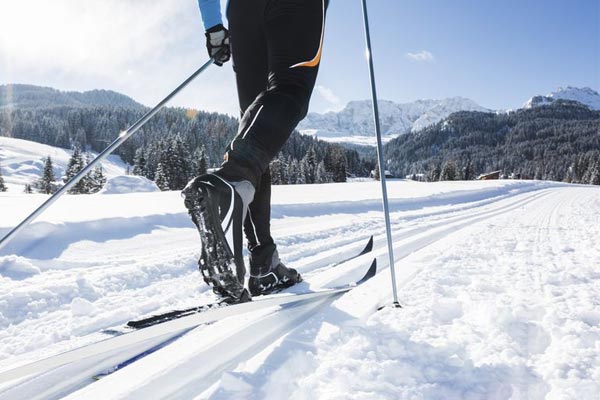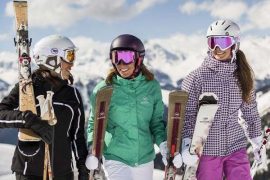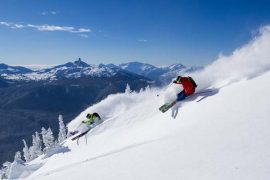Cross-country skiing is a fun, and enjoyable way to exercise and enjoy nature in the winter months.
Despite the sport’s strong ties to Norway and the Olympics, it is not exclusive to that country or elite athletes.
Whether the goal is a family-friendly day in the snow or a calorie-scorching workout, cross-country skiing is a sport that can be enjoyed by people of all ages and abilities.
History
Cross-country skiing has been around for longer than you might imagine. According to Ingebretsens, ancient Scandinavian rock art shows early skis were used for hunting.
Other records report that early skis were used for transportation. In the early 1800’s, Norwegian Sondre Norheim developed modern techniques and equipment that would transform skiing into a recreational activity.
Olympic Skiing
Cross-country skiing has been an Olympic event since the first Winter Olympic games in 1924.
NBC explains the six different competitive formats of cross-country ski races, for men and women, that are held in modern-day Olympics: individual, sprint, team sprint, skiathlon, relay, and mass start.
To maintain the integrity of the classical technique, officials of a classical cross-country ski race can distribute violations if racers make illegal moves when switching tracks or while going around corners, or if caught misusing the herringbone technique.
Distance
Britannica reports that cross-country ski races are typically 10, 15, 30, or 50 km for men, and 5, 10, 15, or 30 km for women.
The ski marathon, or “turrenn” as the Norwegians call it, is a race of 40 km or more.
At 90 km, the Swedish Vasaloppet is the longest and oldest ski race in the world, having been inspired by the rebellious path of Gustav Eriksson Vasa in 1521.
The Norwegian Birkebeinerrennet is another historically significant long distance cross-country ski race.
At 54 km in distance, this race commemorates the rescue of 18-month-old Prince Haakon from civil war-torn Norway in 1206.
What is the difference between cross-country and Nordic skiing?
Nordic skiing is any type of skiing where the binding holds the toe of the boot, but the heel is free.
In comparison, Alpine skiing is any type of skiing where the binding fixes the boot and the heel to the ski.
Nordic skiing encompasses cross-country, telemark, ski jumping, Nordic combined, and the biathlon.
What’s the difference between classic style and skating style?
Sport-conrad.com explains the difference between these two techniques. The classic technique is cross-country skiing in its purest form.
It is described as a natural movement similar to walking, however with a kick to help you glide faster through the snow. Skating style is the controversial modern version of cross-country skiing.
It is characterized by a V shape created by pressing the inner edges of your skis into the snow in order to power forward, in a similar fashion as ice-skating.
Aside from the technique, there are also slight variations in the types of trails and equipment used in each style.
What muscles are used for cross-country skiing?
Cross-country skiing has tremendous anaerobic benefits, helps develop balance, and builds strength.
Humankinetics.com explains that a large number of muscles are used while skiing.
The use of poles exercises the bicep and tricep muscles of the arms, while the coordination and strength necessary for propulsion engage core and leg muscles, particularly the quadriceps and gastrocnemius.
How many calories do you burn cross-country skiing?
Cross-country skiing burns an insane amount of calories. Calorielab.com reports that a 150 lb. a person can burn between 408 – 1,054 calories in an hour, depending on their effort and the terrain. In comparison, walking burns 170 calories an hour.
How fast can you go cross country skiing?
Experienced skiers can actually go quite fast. According to skipost.com, the top racers in the world can reach 40 mph on downhill portions, and 20 mph on flat stretches.
Beginners won’t be able to reach those kinds of speeds, but they will notice an increase in speed with experience and improvement in technique.
Is cross-country skiing difficult?
The answer is yes and no, and honestly depends on an individual’s related experiences and the style being learned.
Cross-country skis can be awkward the first time you put them on, but starting with the classic technique will enable you to shuffle on the snow in no time.
Hills can be a different challenge that results in some falls, but downhill skiing experience can help a skier safely glide down hills if they don’t get overconfident.
Crosscountryskitechnique.com explains some of the differences in skiing techniques and which style is easier.
While the diagonal stride of classic skiing is easier to start with, it is actually more difficult to master.
Skate skiing can be more difficult to learn, but easier once the technique is learned.
Is it a family-friendly activity?
Cross-country skiing can be a fun activity for even the youngest members of a family.
In her blog, Annika Mang gives some excellent advice on how to involve babies and toddlers in this fun outdoor activity.
Nordic Cab demonstrates how these type of trailers work and what it looks like to ski with a trailer.
Can individuals with disabilities participate?
Sports of all kinds are becoming increasingly inclusive of people with disabilities.
According to paralympic.org cross-country skiing became a Paralympic sport open to people with physical or visual impairments in 1976.
They are able to participate with a sit-ski if physically impaired, or a sighted guide if visually impaired.
This YouTube video shows highlights from the cross-country ski races held at the Sochi Paralympic Games in 2014.
Can I take my dog cross-country skiing?
Yes, but xcski.org encourages dog owners to check the rules of the trails before taking their pets out on the trails. Some areas allow dogs off leash while others require dogs to be leashed.
Other areas may not allow dogs at all. Skijoring is a highly coordinated activity where a dog runs ahead of their skiing partner, connected by a special waist belt, in a dog mushing fashion.
Getting Started
In order to get started in the sport of cross-country skiing, you’ll need to make a few purchases and do a little research.
You’ll need to locate cross-country ski trails in your area, will either need to rent or purchase ski equipment and will definitely want to invest in a few accessories for your comfort and safety.
It’s also helpful to find an instructor, or a friend familiar with cross-country skiing to go with.
If a live person is unavailable to help you get started, online videos are another option to help you get started.
Equipment
You’ll need to either buy or rent cross country ski equipment. Rental equipment is an inexpensive way to start skiing and can usually be found in a sporting goods store near your skiing destination. The cost of purchasing ski equipment varies tremendously.
A beginner equipment package could be cheaper than renting if you plan to make skiing a regular activity. Check the prices Whitewoods Adult NNN Cross Country Ski Package on Amazon.
No matter how you choose to acquire gear, the following is a list of the equipment you’ll need to get going on the snow. A more detailed guide for selecting cross country ski equipment can be found at REI.
-Skis with bindings are an obvious necessity for going skiing. The skis are the visible piece of equipment that allows a skier to glide across the snow, but the bindings are an essential component that attaches boots to the skis. Check the prices of Rossignol EVO Glade on Amazon.
-Boots come in a few varieties depending on the type of skiing you intend to do. It is very important to make sure that the boots match the bindings on the skis check the prices of Rossignol Ski Boots on Amazon.
-Poles can also vary slightly depending on the type of cross-country skiing you intend to pursue. Sizing is an important consideration, so look for poles that extend from the ground to your armpits. Check the prices of WINGET Cross X Country Ski Poles on Amazon.
Accessories
Clothing is an essential consideration for a fun and comfortable trip.
Crosscountryskitechnique.com explains more details about choosing the right clothing, including socks and gloves, for your cross-country ski adventure.
As the Norwegians say, “Never bad weather, only bad clothing.” Being very active in a cold environment can pose a bit of a wardrobe dilemma.
Overdressing can cause overheating, while underdressing can dangerously expose a skier to the elements.
Choosing the wrong fabric can even cause problems as your body still produces sweat in cold weather.
The answer to the wardrobe challenge is to wear layers. It is especially important to wear a breathable, moisture-wicking base layer and a lightweight wind and waterproof outer layer.
-Gloves are a necessity for skiing as well. Look for a pair of gloves that are waterproof and have some kind of moisture wicking inner layer. Check the prices of HARAVAL Ski Gloves on Amazon.
-Sunglasses will protect your eyes from the sun, wind, and snow. A pair that has interchangeable lenses will allow a skier to choose the best lenses for the forecast.
Check the prices of DUCO POLARIZED Sports Sunglasses on Amazon.
-A daypack is useful for carrying snacks, drinks, and emergency supplies but its also an easily accessible location in which to stash unwanted layers of clothing. Check the prices of Osprey Packs Daylite Daypack on Amazon.
-Glide wax for skis will eventually be needed when investing in personal equipment.
Even “waxless skis” need glide wax at some point. Check the prices of Maxiglide XC Quick Wax For all Cross Country Nordic Skis on Amazon.
Crosscountryskitechnique.com explains everything you need to know about skis and wax.
-A multifunction watch with an altimeter is another useful purchase. Modern watches have advanced features that can provide details about your adventure, including altitude, distance, and calories burned.
Check the prices of Casio Triple Sensor Digital Display Quartz Black Watch on Amazon.
Low-temperature resistance is also an important consideration if you want to wear a watch while cross-country skiing.
-Families seeking to enjoy cross-country skiing may want to consider a ski trailer to tow less mobile family members.
A trailer adapter kit can convert a bike trailer into a ski trailer for a baby or toddler.
Check the prices of Croozer Ski Adaptor Kit – Fits Kid and Kid Plus Trailers on Amazon.
-A survival kit is a potentially life-saving investment worth purchasing. Nature can be unpredictable and there’s always the potential of getting lost, getting caught in bad weather, or having an accident.
Check the prices of Survive Emergency Survival Kit 13 in 1 on Amazon.
A whistle, signal mirror, fire starter, or emergency blanket could be lifesavers if you experience some kind of emergency during your cross-country ski trip.
Where to go?
Ski resorts often have designated areas for cross-country skiing. The Cross Country Ski Areas Association (CCSAA) has a search feature on their website to help people find a location within a specified distance of the zip code they enter.
Federally designated recreation areas such as State and National Parks, National Forests, Wilderness Areas, and State and National Recreation Areas, are also great places to find designated cross-country ski trails.
Be aware that these locations may require a pass, or have special rules and regulations.
Instruction
What can you do if you can’t find a cross-country skiing instructor or don’t have a friend familiar with the sport?
The following list provides a few short and helpful instructional videos to get you started.
-You can feel like you’re in the heart of Nordic country while watching brief instructional videos published by Tirol.
Thomas, a cross-country skiing instructor at the Cross Country Academy in Seefeld, explains how to perform the classic diagonal stride and how to skate ski.
Although set in Austria, the videos are complete with subtitles in English.
-Daniel from MXC provides more detailed information and instruction for beginners in his Beginner’s Guide to Cross Country Skiing.
He discusses some trail rules as well as how to maneuver on hills.
– In this video, Peter from McBike and Sport describes skate skiing and gives some instruction in technique.
Cross-country skiing has a fascinating history, provides tremendous health benefits, and can be enjoyed in a variety of ways.
Although challenging to learn initially, persistence will pay off. Important steps to getting started include finding trails close to home, using the right equipment and accessories, and learning some techniques.
With a little patience and an adventurous spirit, cross-country skiing can be enjoyed no matter your age or ability level.




